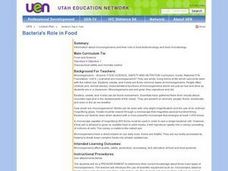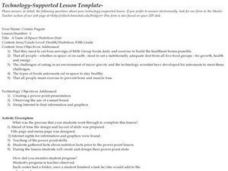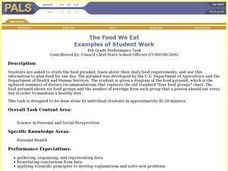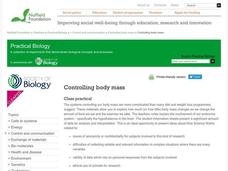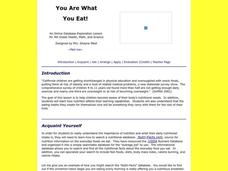Curated OER
Food of the Future
Learners combine their knowledge of genetics, farming and nutrition to design a genetically engineered food. Students focus on how the food will be improved, how it differs from the original product, what types of modifications will be...
University of Georgia
The Power of Peanuts
Measure the amount of energy in a peanut by igniting a chemical reaction. Classes use a laboratory setup to burn a peanut and measure the amount of heat it releases through a temperature analysis. They calculate the number of Joules of...
Curated OER
Bacteria's Role in Food
Young scholars grow bacteria cultures on agar in petri dishes and do a plate count. They participate in a yogurt making lab to see how bacteria produce lactic acid. They prepare a recipe and identify fungi, fermentation and the role of...
Curated OER
Food Math
Fourth graders explore healthy habits by completing caloric measurement activities. In this food choice lesson plan, 4th graders discuss what types of foods give you protein or fat and utilize a food chart to measure caloric intake....
Curated OER
The Food Pyramid
Third graders research a food pyramid website and research a healthy diet. In this food pyramid lesson, 3rd graders complete a puzzle based on the research they've completed and create a healthy main course menu.
Curated OER
The Quicker the Better? Food Processing
Sixth graders explore food processing. In this food processing lesson, 6th graders investigate the effects of processing foods on the food's nutritional value. Students examine a variety of healthy snack options.
Curated OER
A Taste of Space Nutrition Unit
Second graders make a power point presentation about space nutrition and health.
Captain Planet Foundation
George Washington Carver and the Sweet Potato
Learn about George Washington Carver's important contributions to agriculture by studying the sweet potato. First graders read about the inventor's observations and prepare sweet potato slips for the class garden. Additionally, they...
Curated OER
Youth Obesity: Schools Fight Back
Kids fight obesity by comparing the USDA food intake suggestions to what they personally consume throughout the day. They watch a video, read texts, and explore related vocabulary which they use as they compose an oral presentation.
Curated OER
Dollar Value and Fast-Food Nutrition
Students examine how they can make changes to form healthy eating habits. In this investigative lesson students examine food guidelines and the food pyramid.
Curated OER
Getting the Most Nutrition From Your Food
Fifth graders research the food pyramid. In this food pyramid lesson, 5th graders track their eating habits during the day. Later, students review their food log and place each item into the food pyramid.
Curated OER
The Food We Eat
Students plan a menu for one day after they study the food pyramid and learn about their daily food requirements. They are given an updated food pyramid with a summary fo dietary recommendations that replaces the old standard "four food...
Curated OER
Fishing for Good Nutrition
Students identify the food group that various foods fit into according to the food guide pyramid.
Curated OER
The Food Pyramid
Third graders investigate the concept of The Food Pyramid and its importance as a foundation for good health. They use the computer lab as a class to construct projects using the Kidpix software to make their own imitations of The Food...
Curated OER
Food Travels and Preservation
Fourth graders study food processing and distribution. For this food processing lesson, 4th graders investigate various methods of food preservation. Students study methods of food distribution.
Curated OER
Food For Thought
Learners create an individual menu for one of their peers. They must examine their peer's activity level and family history.
Curated OER
Food Classification
Students are introduced to classification and some of the difficulties surrounding classification and how classification systems need to be able to adapt and how they may need to be changed when new information is discovered. They...
Curated OER
Where Do Plants Get Their Food?
Young scholars think about the historical development of the scientific method. They design an experiment that replicates van Helmont's, using only specified materials. Pupils then improved upon van Helmont's procedure and also...
Curated OER
Goal Setting
Students understand how they can incorporate dietary guidelines in their daily life. In this investigative instructional activity students set dietary goals and incorporate an activity to learn how to create a new seed variety while...
Baylor College
What's Is Soil Made Of?
It's time to roll up those sleeves and get a little dirty in the second instructional activity of this series on the science of food. Investigate where plants and animals get the minerals they need to live in this two-part exploration of...
Nuffield Foundation
Controlling Body Mass
Many variables impact your body mass, not just diet and exercise. Scholars collect and study data about body mass to better understand the complexity of a sensitive topic. They learn about leptin deficiency, the hypothalamus, and more.
Curated OER
You Are What You Eat!
Fourth graders discover the nutritional needs of their bodies. Using a database, they research how nutrition affects their learning capabilities. They take the food they eat on a daily basis and discover its nutritional value. They...
Curated OER
The Circulatory System - Part II
First graders recognize that the heart muscle requires food. Students observe a Venn Diagram to identify foods that are good for them. Students provide one ingredient to make healthy heart soup.
Curated OER
Organic Mechanic Part I
On day one of the "Organic Mechanic Part I" lesson plan, learners try to remove the waxy coating of an apple and consider pesticides that may be represented by this addition to our food. On day two, they research pesticides online and...




